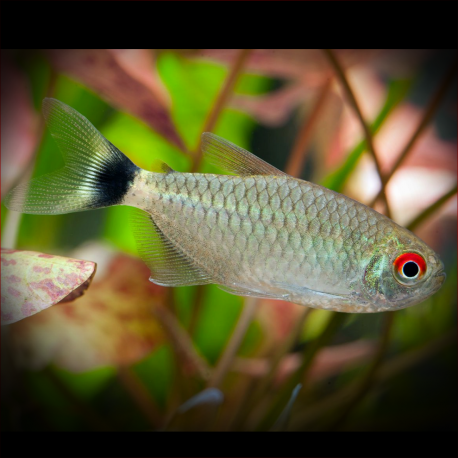More info
Datasheet
| Minimum Tank Size | 106 litres / 28.00 US gallons |
| Maximum Size | 7.0cm / 2.76inches |
| Temperature | 22°C / 71.60°F - 26°C / 78.80°F |
| Hardness | 3-20ºdH |
| pH | 6.0-8.0 |
General Description
The Red-Eye Tetra, scientifically known as Moenkhausia Sanctaefilomenae, is a popular choice in the aquarium trade, particularly for beginners. Native to Brazil, Paraguay, and Argentina, this tetra species is commercially bred in large numbers due to its popularity. It is a small fish, reaching a maximum size of 7.0cm, and falls under the Characidae family. The taxonomic status of the genus Moenkhausia, to which it belongs, is currently uncertain.
Aquarium Setup
The Red-Eye Tetra is quite adaptable and thrives in well-maintained tanks, preferring densely planted environments over brightly lit or sparsely decorated tanks. For those who prefer an Amazonian biotope setup, a substrate of river sand, driftwood branches, twisted roots, and dried leaves can be included to mimic its natural habitat. The addition of aquarium-safe peat in the filter can help simulate black water conditions, with lighting maintained on the dimmer side.
Behaviour
This tetra species is considered a robust choice for a community tank, adding movement and liveliness. While it may nip fins, this behavior can be mitigated by keeping them in a shoal of at least 6-8 individuals where any squabbling is usually contained within the group. Red-Eye Tetras prefer active tankmates and can be kept with other tetras, rainbowfish, larger rasboras, barbs, danionins, and non-aggressive medium-sized cichlids.
Feeding and Diet
The Red-Eye Tetra is easy to feed and accepts a variety of foods, including live and frozen options such as bloodworms, daphnia, and brine shrimp, along with dried flakes, granules, and some vegetable matter like spinach leaves or algae-based flakes. Regular meals of diverse food items contribute to their best condition and vibrant colors.
Reproduction & Dimorphism
Breeding the Red-Eye Tetra involves setting up a separate breeding tank with dim lighting and fine-leaved plants for egg deposition. The water conditions should be soft, slightly acidic, and around 80-84°F. Spawning can occur in groups or pairs, with eggs hatching within 24-36 hours. The female tetras exhibit a rounder body shape during breeding conditions.
Habitat and Distribution
In their native habitat, Red-Eye Tetras inhabit clear water rivers that feed into the Pantanal wetlands, where dense aquatic vegetation like Amazon sword plants and floating species like Eichhornia and Salvinia are common. However, due to their popularity in the aquarium trade, most Red-Eye Tetras available for sale are commercially bred in Eastern Europe rather than sourced from the wild.

